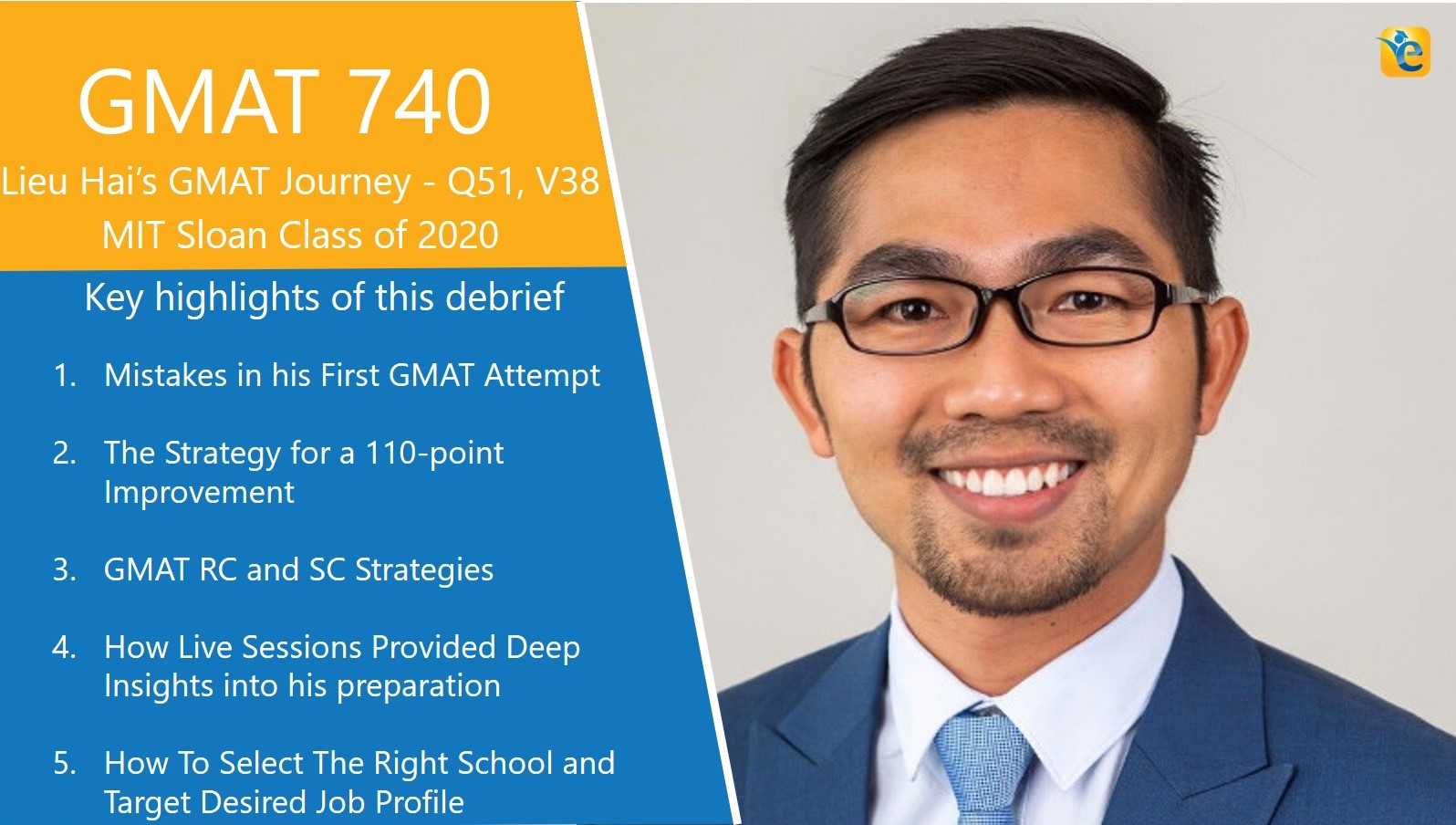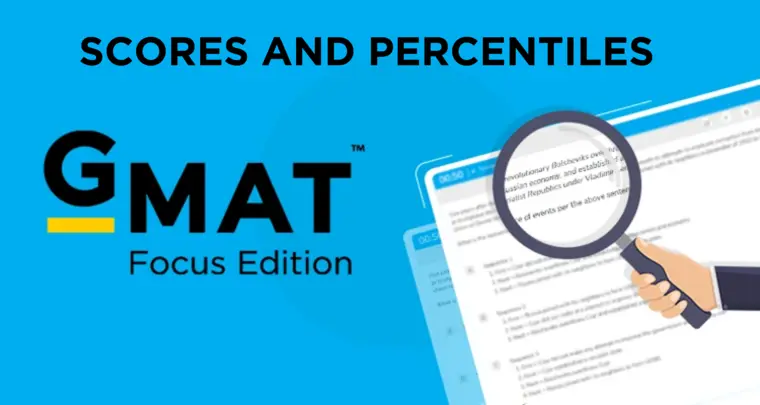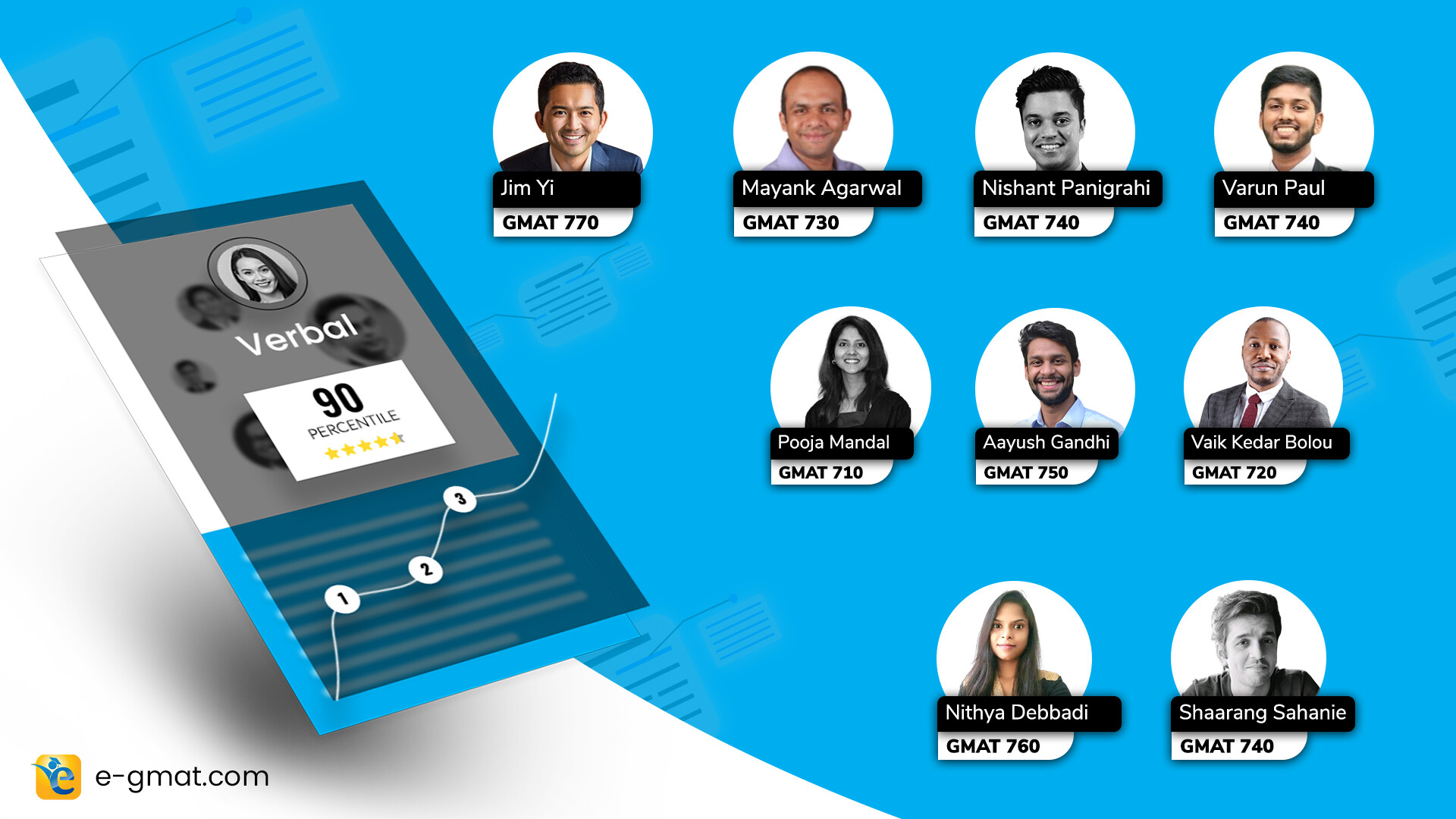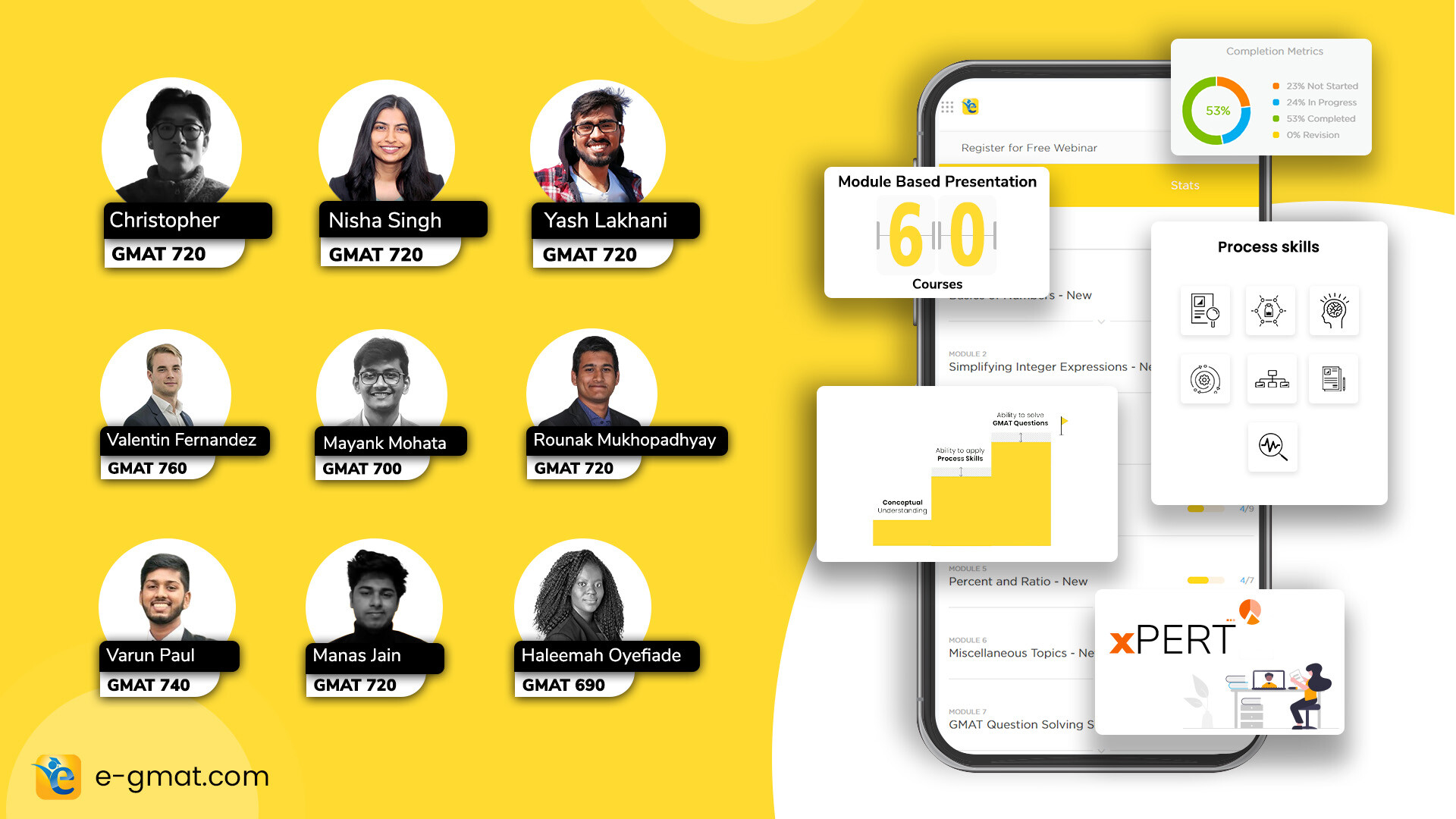“Success is not final; failure is not fatal: It is the courage to continue that counts.” — Winston S. Churchill
After scoring a disheartening 630 GMAT score in his first attempt, Lieu Hai improved his GMAT score by 110-points to score a GMAT 740. He credits his success in the GMAT to a consistent and focused preparation strategy along with a methodical approach.
In this article, he has shared his tips to score a GMAT 740 (Q51 V38) and how he improved his GMAT Verbal score from a V25 to V38.
Bonus: He gets actionable advice on selecting his target business schools and how to smoothen his transition into product management post-MBA.
In the interest of a better reading experience, we have divided this article into two parts as follows:
GMAT Preparation Strategy
Rajat: Congratulations on scoring 740 in the GMAT and on improving from a V25 to V38. How does it feel?
Thank you, Rajat! It feels amazing to score a 740 on the GMAT. To tell you truthfully, I always thought that it would be difficult to score 700+ and knowing myself I knew it would be great to score a 720. However, on test day I managed to surprise myself by improving my quant score to a Q51 which helped me boost my GMAT score further.
I have to admit, after scoring a 630 in my first attempt I felt disheartened. But I soon realized that it was an accurate reflection of my GMAT preparation until that point. Thus, it gave me the stimulus to introspect and improve my preparation strategy and studying habits.
Rajat: How did you study for your first attempt and what went wrong?
I started my GMAT preparation with the usual recommended GMAT preparation books and resources after some online research. However, my preparation lacked consistency. This was partly due to my work which had 12+ hour shifts on offshore oil platforms. I would be offshore for 1-3 weeks at a stretch.
To add to this, I lacked a methodical approach. For example, when I solved questions, I would not pay attention to why I got a question right or wrong. And why were the wrong choices wrong. I felt this was the wrong approach towards GMAT Preparation.
First GMAT attempt
Going into my first GMAT attempt, I was aiming for a score of 670-680. However, the disheartening 630 GMAT score made me look critically at my preparation and reflect on what I should do to reach my target GMAT score.
To not fall back into my old habits of inconsistent studying I created a plan and developed a strategy for my second GMAT attempt. I remember it was my wife who convinced me to go for the e-GMAT course after researching it online and going through the reviews. I knew that I could do self-study, however having a tutor has always helped, and hence I went with my wife’s suggestion and purchased the e-GMAT course.
Rajat: How did you prepare for GMAT Verbal and improved from a V25 to V38 in your second attempt?
I started my GMAT verbal preparation with sentence correction.
GMAT SC preparation Strategy
I would say that the e-GMAT sentence correction module rocks. I went through the interactive course in detail making sure I paid attention and learned all the concepts required to solve questions.
Attending Live Sessions
At first, I was apprehensive of the helpfulness of the live sessions. I used to think that I am already confident and well prepared and how would a live session help me? However, attending the live session was a revelatory and amazing experience.
The in-depth explanations that are offered for each question and the insights which the experts bring into the session enhanced my understanding of each topic tremendously. E.g., by attending the live session I was able to understand the process to eliminate wrong answer choices in SC questions. This fundamentally changed the way I approached GMAT sentence correction.
Attend our GMAT SC webinar and learn how to tackle GMAT SC questions with ease.
I believe that 80%-90% of the questions fall into the typical type of GMAT SC questions containing a particular type of sentence and grammatical structure. However, there are that 10%-20 % of questions that have a peculiar grammatical and sentence structure, and I made sure to make a note of these questions.
GMAT Reading Comprehension Strategy
I followed the e-GMAT approach to RC questions of making a paragraph summary while reading the passage. I made a 3-5 word summary of each paragraph in the passage after reading the paragraph. I knew that it wasn’t necessary that each paragraph would contain a major change in the idea as such. This habit helped me in the following 2 ways:
- Keep track of the major ideas of the passage
- Be more focused and engaged while reading the passage
I learned early on that being engaged with the passage was essential to mastering reading comprehension.
How this habit extends to business school
Rajat: That is a great approach! And when you think of it, this would help not only in the GMAT but also in business school and beyond.
In business school, you would be reading a lot of cases. Essentially each case is about 12 pages long, and you would get about 20 minutes to read the case. And another 20 minutes to look at the accompanying charts, data, and illustrations in the appendix.
Thus, a similar process is needed while reading through the case, where you summarize each paragraph in 3-5 words. In this way, the second reading requires only 1-2 minutes as you only go through paragraph summaries. And this second read will be needed to look at the data in context with what is mentioned in the case.
Thus, the same habit becomes very helpful in business school.
Rajat: How did you use Scholaranium during your preparation?
I found Scholaranium very helpful in simulating a test day environment. Practicing on Scholaranium helped me in 2 ways:
- Simulates the test environment perfectly
- Helped me with time management by providing insightful data and analytics about my performance
I must say that despite performing poorly in the initial quizzes that I took, I could see my progress as my preparation moved forward.
If you want to try out the e-GMAT course that helped Lieu Hai make the jump of 110 points from 630 to 740, sign up for our Free Trial. We can also help you with a personalized study plan and give you access to quality online content to prepare. Write to us at acethegmat@e-gmat.com. We are the most reviewed GMAT prep company on GMATClub with more than 2100 reviews.
Key takeaways from Lieu Hai’s GMAT Preparation
- It is important to review your preparation and understanding after solving a question or a quiz. The insights gained from this provide a direction to your GMAT preparation and help you decide areas of focus.
- Writing down 3-5 word paragraph summaries for RC passages is essential.
- Live sessions offer in-depth insights into a particular topic and are a must to attend.
Business School Selection
Rajat: Let us talk about your target business schools.
Before my first GMAT attempt, I was targeting the top-10 business schools. However, after scoring a 630, I readjusted my expectations and decided to aim for the top-20 schools. Now with a 740 GMAT score, I am aiming for the M7 business schools.
Post MBA Career Goals
I want to transition into product management post my MBA in the e-commerce or tech industry. Target employers would be Amazon, Cisco, and Google, etc. Given that I do not have a technology background it seems to be a difficult transition.
Learn more about post MBA careers and salaries in this article.
Rajat’s advice on how to handle a career transition through B-school
Rajat: It’s not hard per se, but it is really important to know what you need to do to overcome your lack of a tech background. E.g. I wanted to transition into marketing, and my background was in research with no prior marketing experience.
However, since I knew this, I was able to focus on making that transition by choosing the right internships and courses during my MBA. And focusing on attending and possibly winning marketing competitions. Thus, it is important to create a path that will help you smooth the transition into your post MBA career.
Rajat’s advice on business school selection for product management
When you look at business schools it is important to do research the following to determine the right ‘fit’:
- Research clubs and centers of excellence
- Employment reports
- Location
Clubs and Centers of excellence
These will help you determine the school’s focus area. However, it is essential to understand this in context with the size of the class.
E.g., Harvard has an MBA class of around 900 students, and it has a technology club. But it is also important to look at the participation in each of these clubs. It is a given that some students in a class of 900 would be heading into technology. However, the amount of participation in the technology club with respect to the class size would give you a clear idea of the school’s focus area.
Centers of excellence give an insight into the areas of research being explored by the faculty. This will give you an idea about the focus areas of the faculty of a particular business school.
Employment Reports
The employment reports of the business schools give you a clear idea of the kind of peer group that you can expect at a business school and their post MBA career aspirations.
E.g., A third of the MBA class at Dartmouth Tuck School of Business goes into consulting post their MBA. The kind of peer group would be different as compared to UCLA Anderson where the class profile is different. Thus, the discussions you would have and the kind of contacts and network you would make would be fundamentally different.
Location
The location of the business school and its proximity to the industry hubs is also important. For example, the hubs for the technology industry in America are:
- Bay Area
- Washington State
- New York City
- Boston
- Northern Texas
Schools in these areas would have strong recruiting ties with technology organizations such as Amazon and Microsoft in Washington state etc. This would help you in your transition to technology product management post MBA.
Doing the above research about your target business schools would help you in the following ways:
- Increase chances of acceptance because of a better
- Increase the chances of receiving scholarships/fellowships
- Improves the odds of a successful transition into desired post-MBA career.
Thank you, Rajat for your insightful advice about selecting business schools. I look forward to the application process and would keep you posted about my progress.
Rajat: Best of luck in your application process.
In case of any questions, please write to us at acethegmat@e-gmat.com


















